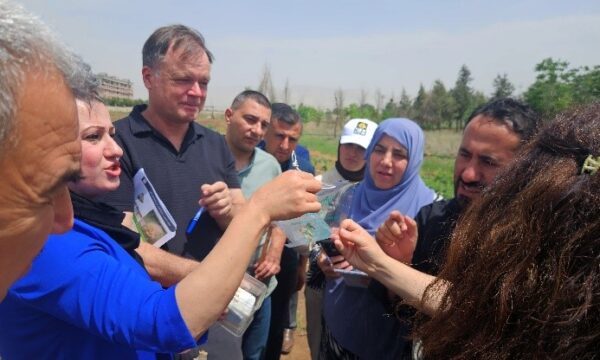By Trudy Harris. Originally published on SciDev.Net.

Farmers and authorities throughout Asia need to be vigilant against fall armyworm invasions, after confirmation that the fast-moving pest has spread from India to China and now to South-East Asia, agricultural experts say.
The highly destructive moth (Spodoptera frugiperda), native to North and South America, has been steadily moving east since 2016, causing up to US$3 billion worth of damage to maize and other crops in Africa, according to reports. The pest reached India in July last year before hitting Bangladesh and Sri Lanka.
“During the last 6—7 months, fall armyworm has spread from India to China, and will continue to spread in China. It has reached Myanmar and Thailand and it will also spread to Vietnam sooner or later”
Hans Dreyer, Food and Agriculture Organization
“During the last 6—7 months, fall armyworm has spread from India to China, and will continue to spread in China. It has reached Myanmar and Thailand and it will also spread to Vietnam sooner or later,” says Hans Dreyer from the UN’s Food and Agriculture Organization (FAO).
“Countries have to be very vigilant but also not panic,” Dreyer, director of the FAO’s plant production and protection division, tells SciDev.Net.
The moth is capable of flying long distances while the caterpillar can devastate crops such as maize, rice and sugarcane overnight. “Within a couple of weeks, it can move several hundred thousand kilometres,” Dreyer says.
Although Asian countries are mostly known for growing rice, maize is also a staple crop and an important source of feed for livestock and poultry. China, the largest producer of maize in Asia and the second largest globally, was hit in January when the pest invaded the southern Yunnan province.
Agricultural officials and other experts across Asia gathered in Bangkok this week (20-22 March) to share information and strategies on monitoring and containing the pest. Experts at the conference, convened by the FAO, emphasised the need for early detection and sustainable management of confirmed infestations.
Mechanisms, such as pheromone traps set up in fields, need to be in place throughout South-East Asia to check for the insects, and farmers and others trained to identify them, says Malvika Chaudhary, from the non-profit Centre for Agriculture and BioScience International (CABI).
“South-East Asia is susceptible, so everyone should be very alert,” says Chaudhary, a regional coordinator at CABI, the parent organisation of SciDev.Net.
CABI, which has experience in managing the pest in Latin America, Africa and India, has been holding plant clinics in the region to share knowledge and provide support on tackling the pest. The FAO has also developed an app that teaches farmers and officials how to find and deal with fall armyworms.
Dreyer cautions against relying on chemical pesticides which could have negative consequences for the environment and are costly, especially for small-scale farmers. FAO is working with authorities on informing and training farmers on integrated pest management techniques, including identifying and then using the insect’s natural enemies, such as parasites or pathogens, to help control it.
“Pesticides are certainly part of the equation, but should really be considered as a last resort, used in dramatic, emergency situations when it’s really justified as a solution,” he says.
China’s Yunnan province was hit in January and predictions by the Chinese Academy of Agricultural Sciences forecast that the pest could reach the country’s main maize production region in the north and northeast this summer which starts in June, the conference was told.
China was undertaking national action with multiple stakeholders to monitor, research and contain the pest, while also informing and educating officials and farmers. Farmers need to carefully consider ecological impacts before resorting to pesticides, says Yang Puyun from China’s ministry of agriculture and rural affairs.
Yang says that continued international cooperation, such as with agencies and neighbouring countries, to monitor and manage the pest is also important.
In Thailand, more than 50 provinces that grow maize have been hit after the pest is thought to have travelled over the border from Myanmar late last year. The worm has invaded all stages of some crops, burying deep into the plants and turning the corn to mush.
“Since we first found fall armyworm in Thailand, it has spread very fast from the border to the other side of the country and to the south,” Sarute Sudhi-Aromna, a senior official from Thailand’s ministry of agriculture and cooperatives, told the conference, saying crop losses have been estimated at between US$130 million to US$260 million. It’s estimated that 25 to 40 per cent of the country’s one million hectares of corn will be affected.
“The western side of the country has been badly affected. We have found many generations of the pest in the same field. It’s very serious now in Thailand.”
1 Comment
Leave a Reply
Related News & Blogs
Biological control in action: Zambia’s field days on fighting fall armyworm
Experts from CABI recently held two field days and an expo in Zambia, showcasing innovative approaches to pest management to 584 farmers, agro-dealers and other stakeholders to help raise awareness of approaches to tackle the invasive fall armyworm (Sp…
11 June 2025





[…] been on the ground working hard to help farmers manage and control pests like banana skipper and fall armyworm. The session proved to be very popular with maximum participation and was attended by researchers, […]